
The Haardter Bürgergarten vineyard in Pfalz
The Nahe wine region is located east of the Mosel, along the Nahe river, which is one of the western tributaries to the Rhine. The name Nahe is derived from the Latin word Nava, itself derived from an old Celtic word meaning wild river. Although the Nahe is one of the smallest wine regions in Germany, it has a rich and varied range of soil types, including volcanic rocks, weathered stone, and red, clayish slate and can therefore produce a large variety of wine styles.
The wines we tasted:
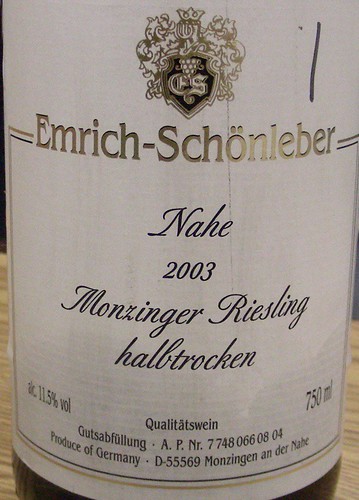 • 2003 Emrich-Schönleber Monzinger Riesling halbtrocken: Weingut Emrich-Schönleber is an estate of 13 hectares with more than three-quarters devoted to Riesling. The vineyard is made of slopes facing south to south-west that receive an optimum of midday sun. More specifically, the Monzinger hill has steep slopes that have unique microclimatic conditions: the warm air from the valley rises over the slopes and protects the vines from the chilly downdrafts at night. The wine had a bright golden color and an aromatic nose of white peach. On the palate, it was semi-sweet with a sharp acidity. A pleasant but not overly complex wine.
• 2003 Emrich-Schönleber Monzinger Riesling halbtrocken: Weingut Emrich-Schönleber is an estate of 13 hectares with more than three-quarters devoted to Riesling. The vineyard is made of slopes facing south to south-west that receive an optimum of midday sun. More specifically, the Monzinger hill has steep slopes that have unique microclimatic conditions: the warm air from the valley rises over the slopes and protects the vines from the chilly downdrafts at night. The wine had a bright golden color and an aromatic nose of white peach. On the palate, it was semi-sweet with a sharp acidity. A pleasant but not overly complex wine.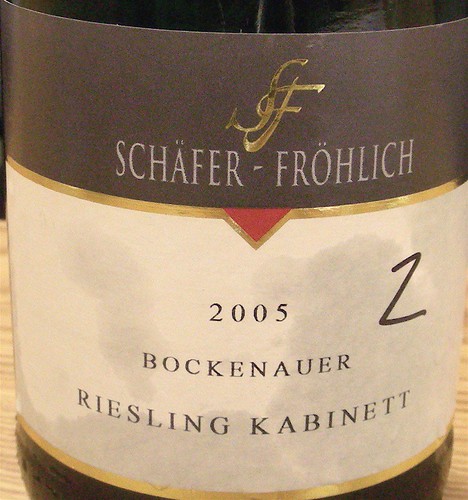 • 2005 Schäfer-Fröhlich Bockenauer Riesling Kabinett: although the Schäfer-Fröhlich family has been producing wines since the 1800's, Weingut Schäfer-Fröhlich is now considered a rising star among the Nahe wineries. The estate has 10 hectares planted with Riesling, and Pinot varietals. The wine had a pale yellow color and an appealing floral nose. The palate had a lively acidity with aromas of stone fruits. Delicious!
• 2005 Schäfer-Fröhlich Bockenauer Riesling Kabinett: although the Schäfer-Fröhlich family has been producing wines since the 1800's, Weingut Schäfer-Fröhlich is now considered a rising star among the Nahe wineries. The estate has 10 hectares planted with Riesling, and Pinot varietals. The wine had a pale yellow color and an appealing floral nose. The palate had a lively acidity with aromas of stone fruits. Delicious!We tasted the Schäfer-Fröhlich side by side with a California Chardonnay, the 2005 Kendall-Jackson Jackson Estates Grown Chardonnay, which I found heavy and oaky in comparison.
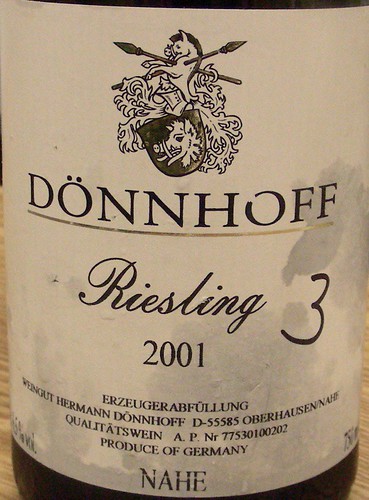 • 2001 Hermann Dönnhoff Riesling: Weingut Hermann Dönnhoff is one of the leading estates of the region. This estate of over 12 hectares has been in the Dönnhoff family since 1750 and comprises some of the top sites of the Nahe Valley. The wine had a deep golden color and a vivid nose with petrol notes. On the palate, it was rich, unctuous and seemed less acidic than the first two Rieslings. Maybe my favorite Nahe wine.
• 2001 Hermann Dönnhoff Riesling: Weingut Hermann Dönnhoff is one of the leading estates of the region. This estate of over 12 hectares has been in the Dönnhoff family since 1750 and comprises some of the top sites of the Nahe Valley. The wine had a deep golden color and a vivid nose with petrol notes. On the palate, it was rich, unctuous and seemed less acidic than the first two Rieslings. Maybe my favorite Nahe wine.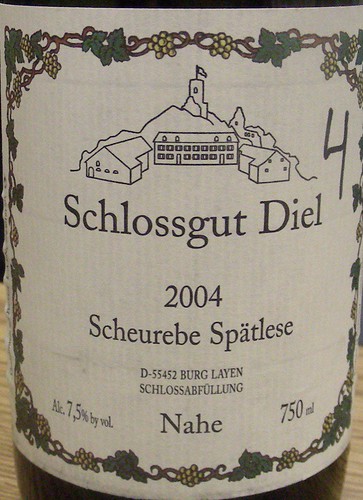 • 2004 Schlossgut Diel Scheurebe Spätlese: Weingut Schlossgut Diel, a pre-eminent estate in the Nahe, has been owned by the Diel family since 1802. It is located at the lower end of the Nahe river close to the estuary of the Rhine, and has some of the best vineyards of the region. The wine was a Scheurebe, which is a crossing of Silvander and Riesling. It had a deep golden color and a pungent nose of green apple. The palate attack was dense with strong aromas of spicy apple pie that evolved into a sweet and cloying finish, actually, too sweet and cloying for my personal taste.
• 2004 Schlossgut Diel Scheurebe Spätlese: Weingut Schlossgut Diel, a pre-eminent estate in the Nahe, has been owned by the Diel family since 1802. It is located at the lower end of the Nahe river close to the estuary of the Rhine, and has some of the best vineyards of the region. The wine was a Scheurebe, which is a crossing of Silvander and Riesling. It had a deep golden color and a pungent nose of green apple. The palate attack was dense with strong aromas of spicy apple pie that evolved into a sweet and cloying finish, actually, too sweet and cloying for my personal taste.The Rheinhessen is Germany's largest wine region. It lies in a valley of gentle rolling hills, bordered on the west by the Nahe River and on the north and east by the Rhine. Overall, this is a fertile region with vast farmlands that may lack character except where the Rhine has carved steep slopes, which is where the best vineyards lie.
The wines we tasted:
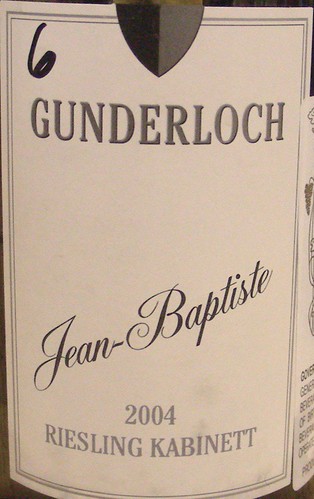 • 2004 Gunderloch Jean-Baptiste Riesling Kabinett: Carl Gunderloch, a banker from Mainz, founded the Gunderloch estate in 1890 and is the great, great grandfather of Agnes Hasselbach, the current owner. The Jean-Baptiste label is an allusion to a character called Jean Baptiste Gunderloch in the German dramatist Carl Zuckmayer's play The Jolly Vineyard. The wine had a dark golden color, notes of petrol on the nose, apple-pear flavors on the palate and a rather short finish.
• 2004 Gunderloch Jean-Baptiste Riesling Kabinett: Carl Gunderloch, a banker from Mainz, founded the Gunderloch estate in 1890 and is the great, great grandfather of Agnes Hasselbach, the current owner. The Jean-Baptiste label is an allusion to a character called Jean Baptiste Gunderloch in the German dramatist Carl Zuckmayer's play The Jolly Vineyard. The wine had a dark golden color, notes of petrol on the nose, apple-pear flavors on the palate and a rather short finish.We tasted this wine side by side with the 2004 Poet's Leap Riesling Columbia Valley, a Washington State wine crafted by Armin Diel of Weingut Schlossgut Diel. It had a light yellow color with notes of petrol and chemical aromas on the nose and a palate that I found less clean and less focused than the Jean-Baptiste.
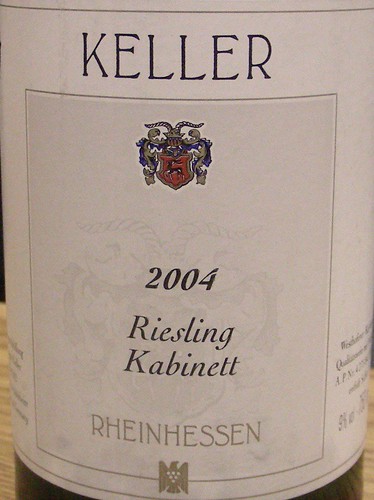 • 2004 Keller Westhofener Kirchspiel Riesling Kabinett: the Keller family owns 16 hectares of vines in prime spots. One of them is the Kirchspie, east-southeast facing slopes, windless and quite warm, with marl and limestone. The wine had a light yellow color and a volatile nose of burnt sugar. On the palate, it was slightly fizzy with notes of caramel, had a good acidity and a lingering finish of spicy apple cider.
• 2004 Keller Westhofener Kirchspiel Riesling Kabinett: the Keller family owns 16 hectares of vines in prime spots. One of them is the Kirchspie, east-southeast facing slopes, windless and quite warm, with marl and limestone. The wine had a light yellow color and a volatile nose of burnt sugar. On the palate, it was slightly fizzy with notes of caramel, had a good acidity and a lingering finish of spicy apple cider.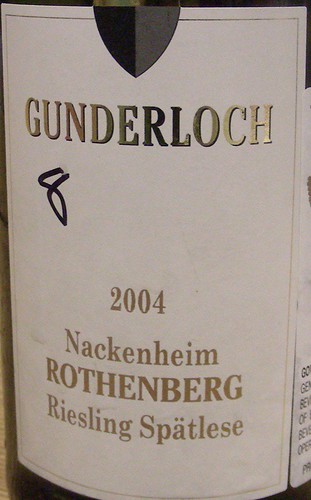 • 2004 Gunderloch Nackenheim Rothenberg Riesling Spätlese: Weingut Gunderloch is famous for its Riesling from the premium red slate based Nackenheim Rothenberg vineyard. The wine had a deep golden color and a rich mineral nose. On the palate, it was full-bodied, sweet, with ripe fruit aromas. Definitively the most complex wine out of this Rheinhessen selection.
• 2004 Gunderloch Nackenheim Rothenberg Riesling Spätlese: Weingut Gunderloch is famous for its Riesling from the premium red slate based Nackenheim Rothenberg vineyard. The wine had a deep golden color and a rich mineral nose. On the palate, it was full-bodied, sweet, with ripe fruit aromas. Definitively the most complex wine out of this Rheinhessen selection.The Pfalz is Germany's warmest wine region. It lies between the densely forested Haardt Mountains (an extension of the French Vosges) and the Rhine plain. Like Alsace in France, it is sunny and dry thanks to the Haardt mountains protecting the region from the cold and rainy weather coming from the west. The word Pfalz is a derivation of the Latin word palatium which means palace. Crops like almonds, peaches, apricots, cherries, sweet chestnuts, walnuts, figs, and tobacco flourish in this almost Mediterranean climate. It is Germany's most productive wine region and currently the most exciting. Ambitious growers are increasingly experimenting with a wide range of white and red grapes.
The wines we tasted:
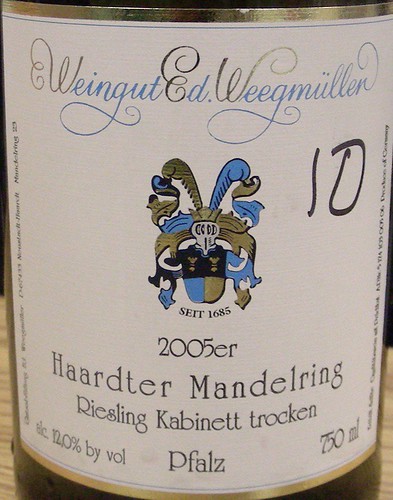 • 2005 Ed. Weegmüller Haardter Mandelring Riesling Kabinett Trocken: Weingut Ed. Weegmüller has over 15 hectares in the renowned wine village of Haardt near the town of Neustadt. The wine had a light yellow color and a citrus nose. On the palate, it was slightly fizzy, rather dry, spicy, with a vibrant acidity.
• 2005 Ed. Weegmüller Haardter Mandelring Riesling Kabinett Trocken: Weingut Ed. Weegmüller has over 15 hectares in the renowned wine village of Haardt near the town of Neustadt. The wine had a light yellow color and a citrus nose. On the palate, it was slightly fizzy, rather dry, spicy, with a vibrant acidity.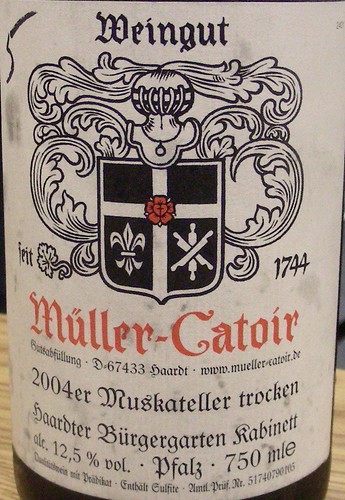 • 2004 Müller-Catoir Haardter Bürgergarten Muskateller Kabinett Trocken: Weingut Müller-Catoir has 20 hectares located in Haardt. Considered to be the classiest estate in the Pfalz, it produces some of the country's finest Rieslings. The estate mostly grows Riesling, with some Weißburgunder, Grauburgunder, Spätburgunder, and very small quantities of Rieslaner, Scheurebe and Muskateller (Muscat). This Muskateller had a pale straw color and an aromatic grapey nose. On the palate, it was fresh and slightly fizzy with some herby aromas on the finish.
• 2004 Müller-Catoir Haardter Bürgergarten Muskateller Kabinett Trocken: Weingut Müller-Catoir has 20 hectares located in Haardt. Considered to be the classiest estate in the Pfalz, it produces some of the country's finest Rieslings. The estate mostly grows Riesling, with some Weißburgunder, Grauburgunder, Spätburgunder, and very small quantities of Rieslaner, Scheurebe and Muskateller (Muscat). This Muskateller had a pale straw color and an aromatic grapey nose. On the palate, it was fresh and slightly fizzy with some herby aromas on the finish. • 2002 Lingenfelder GanYmed Spätburgunder Trocken: the Lingenfelder family has been making wine in the Pfalz for 13 generations. They own 15 hectares of prime vineyards, planted mostly with Riesling, Scheurebe and Spätburgunder (Pinot Noir). Their Spätburgunder is planted on limestone soil in the Burgweg site that slopes down just behind the winery. Ganymed is a special Pinot Noir cuvee named after the Greek sommelier to the gods and it is made only during exceptional vintages. It is aged in new oak barriques in order to develop complexity and structure. The wine had a brown/brick color and an attractive nose of black cherries. On the palate, it was smoky and gamey with notes of licorice on the finish. An elegant and classy Pinot Noir.
• 2002 Lingenfelder GanYmed Spätburgunder Trocken: the Lingenfelder family has been making wine in the Pfalz for 13 generations. They own 15 hectares of prime vineyards, planted mostly with Riesling, Scheurebe and Spätburgunder (Pinot Noir). Their Spätburgunder is planted on limestone soil in the Burgweg site that slopes down just behind the winery. Ganymed is a special Pinot Noir cuvee named after the Greek sommelier to the gods and it is made only during exceptional vintages. It is aged in new oak barriques in order to develop complexity and structure. The wine had a brown/brick color and an attractive nose of black cherries. On the palate, it was smoky and gamey with notes of licorice on the finish. An elegant and classy Pinot Noir.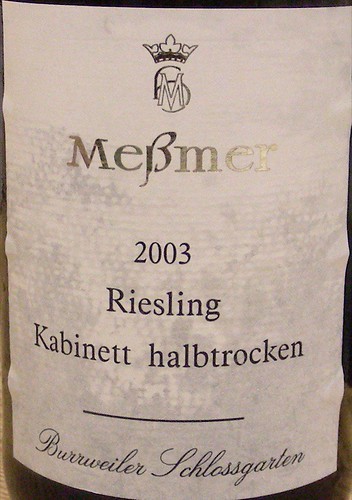 • 2003 Messmer Burrweiler Schlossgarten Riesling Kabinett halbtrocken: Weingut Messmer is an estate located in Burrweiler, in southern Pfalz. This wine comes from Schlossgarten, one of the estate's best sites with a soil of loam and lime deposits. It had a light straw color and a mineral nose. On the palate, it was nicely fruity with a great amount of acidity.
• 2003 Messmer Burrweiler Schlossgarten Riesling Kabinett halbtrocken: Weingut Messmer is an estate located in Burrweiler, in southern Pfalz. This wine comes from Schlossgarten, one of the estate's best sites with a soil of loam and lime deposits. It had a light straw color and a mineral nose. On the palate, it was nicely fruity with a great amount of acidity.At the end of the class, there was a surprise bottle that we tried to identify, although unsuccessfully (does that mean that we need to retake the class and retaste all these great wines?):
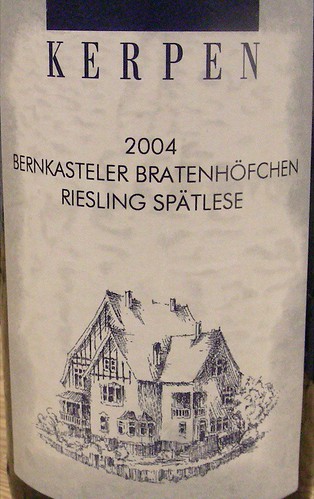 • 2004 Kerpen Bernkasteler Bratenhöfchen Riesling Spätlese: the Bernkasteler Bratenhöfchen vineyard is one of the premium sites owned by the Kerpen family. It is located on the Middle Mosel River. Unfortunately, I was too busy trying to identify the wine and I forgot to take notes. The only thing I remember is that the wine was delicious.
• 2004 Kerpen Bernkasteler Bratenhöfchen Riesling Spätlese: the Bernkasteler Bratenhöfchen vineyard is one of the premium sites owned by the Kerpen family. It is located on the Middle Mosel River. Unfortunately, I was too busy trying to identify the wine and I forgot to take notes. The only thing I remember is that the wine was delicious.Coming next: the wines from Austria
Related story: Wines of Germany and Eastern Europe class: Rheingau, Mosel-Saar-Ruwer, and Mittelrhein
Technorati tags: wine food & drink
4 comments:
Wow! A great lineup of wines (even though the Dornhoff is not one I'd use as an example). The one I'd most want to taste is: 2002 Lingenfelder GanYmed Spätburgunder. Either the 1997 or 98 was wonderful; never could get more than the one bottle. :(
Yes, the GanYmed was one of my favorites and it was a discovery too. I didn't know that pinot noir from Germany could be so flavorful.
Yeah, I pushed for a single-vineyard Donnhoff. But I work under the "beggars can't be choosers" shopping principle. The Lingenfelder was quite good. It must be around somewhere, because I got it from Hiram. I don't know how wide his range is, though.
Does anybody know if the Ganymed 1997 pinot noir by Weingut Lingenfelder is worth anything. It has a naked man illustrated on the label.
Renee
Post a Comment